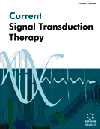Current Signal Transduction Therapy - Current Issue
Volume 20, Issue 1, 2025
-
-
Computational Evaluation of ADMET Properties and Molecular Docking Studies on Cryptolepine Analogs as Inhibitors of HIV Integrase
More LessAuthors: Rajeev Gupta, Amir Raza, Shivam Kumar Singh, Jasmeen Kaur and Pankaj WadhwaBackgroundHIV/AIDS remains a global health challenge, demanding innovative antiretroviral strategies. HIV integrase inhibition, a promising therapeutic target, warrants exploration. This study investigates the potential of Cryptolepine and analogues as integrase inhibitors through in-silico docking and ADMET profiles. Docking simulations reveal binding affinities, guiding rational drug design. ADMET predictions assess the ph Read More
-
-
-
Exploring 5-Benzylthiazolidine-2, 4-Dione Derivatives as Promising PPAR-gamma Agonists through Computational Methods
More LessAuthors: Solomon Gyampoh, Minnatullah Nabi, Pinky Arora and Shubham KumarIntroductionPeroxisome Proliferator-Activated Receptors (PPARs) are nuclear receptors involved in the regulation of glucose and lipid metabolism, making them potential targets for treating type 2 diabetes mellitus. 5-Benzylthiazolidine-2, 4-dione derivatives, organic compounds with a thiazolidine-2, 4-dione core and a benzyl moiety at the 5-position, have garnered attention for their diverse pharmacological activities, in Read More
-
-
-
PPAR-γ Signaling and Common Protective Pathways against Obesity and Alzheimer's Disease
More LessAuthors: Akhil Sharma, Sushma Devi, Ashi Mannan, Manish Kumar and Thakur Gurjeet SinghTranscription factor PPAR-γ is predominantly found in adipose tissue, liver, and brain. PPARs form heterodimers, interact with ligands, and regulate the expression of the genes of the PPAR-γ downstream regulatory pathways. PPAR-γ is critical in regulating many physiological processes, including adipogenesis, glucose metabolism, fatty acid metabolism, energy homeostasis, and inflammation. This review is on the functions of PPA Read More
-
-
-
Bioactive Compounds Aimed at the AMPK Pathway: A Window into their Therapeutic Potential
More LessCurrent investigations have proposed that focusing on malignancy cell metabolism is an elective restorative methodology in cancer treatment. AMPK is the significant energy sensor regulating ordinary as well as malignancy cell metabolism. Drugs as AMPK activators can quell malignancy cell development through the various signalling cascade. AMPK enactment in light of natural AMPK activators, for example, BME, ICT, Th Read More
-
Volumes & issues
-
Volume 20 (2025)
-
Volume 19 (2024)
-
Volume 18 (2023)
-
Volume 17 (2022)
-
Volume 16 (2021)
-
Volume 15 (2020)
-
Volume 14 (2019)
-
Volume 13 (2018)
-
Volume 12 (2017)
-
Volume 11 (2016)
-
Volume 10 (2015)
-
Volume 9 (2014)
-
Volume 8 (2013)
-
Volume 7 (2012)
-
Volume 6 (2011)
-
Volume 5 (2010)
-
Volume 4 (2009)
-
Volume 3 (2008)
-
Volume 2 (2007)
-
Volume 1 (2006)
Most Read This Month Most Read RSS feed
Article
content/journals/cst
Journal
10
5
false
en


